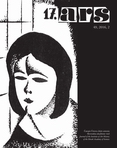
Journal ARS 49 (2016) 2
Štefan VALÁŠEK
Eucharistic Triptych in All Saints Church in Ludrová – Kút in Liptov. Its Function and Iconography
(Summary)
The main objective of the presented study is an iconographic analysis of votive triptych in All Saints Church in Ludrová - Kút in Liptov region. In the introductory part, the author deals with the historiography of murals in Ludrová and also provides a brief history. The triptych on the north nave of the church was discovered by conservator Mikuláš Štalmach in 1960. A detailed iconographic analysis of this wall painting from the late 14th century or from the time around year 1400 was missing in the Slovak historiography of art history. Based on the formal and comparative analysis, the author makes new discoveries and explores the work of art in the context of a new piety (the author understands devotio moderna in the broad sense of the word) and ars moriendi. Using the comparative method, the author identified the original text of the scroll located inside the image of the Virgin of Mercy. In Koprzywnica of Lesser Poland, Poniky and Želiezovce, in the scenes of Battle for the soul is depicted the inscription: "Hanc animam posco quam plenam crimine nosco". It is a text based on the contemporary compendia and tractates on good death, namely the struggle between the devil and angel for the soul of dying person. The iconography of the triptych in Ludrová - Kút is unique and innovative at the same time. The image of the Virgin of Mercy associated with the text originating in the display of Battle for the soul is a unicum in the Central European area. The inscription tape in the painting in Ludrová’s Virgin of Mercy probably refers to the female donor of the triptych, who is kneeling and adoring Christ in Imago Pietatis type. The central scene of the triptych is the Man of Sorrows, Christ standing with open arms and ostentatio vulnerum gesture. Thanks to detailed formal and iconographic analysis, the author examines the impact of the contemporary liturgy on the formation and development of Eucharistic iconographic themes, most prevalent of which was in the late Middle Ages precisely type Imago Pietatis. After detailed investigation of the mural, the author concludes that it is a votive Eucharistic triptych, since the central theme of the painting is Man of Sorrows adored by the female donor. At the same time, eschatological motifs are also part of the triptych – devil fighting for female soul and the protection of Virgin of Mercy. Precisely Virgin Mary and Christ were the main intercessors in the judging of the donor’s soul. Belief in the mercy and the intercession of the heavenly patrons in the hour of one’s death became one of the main themes of the late Middle Ages.